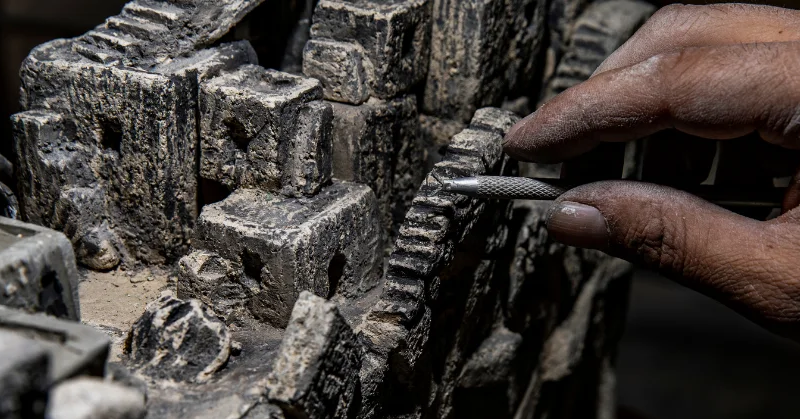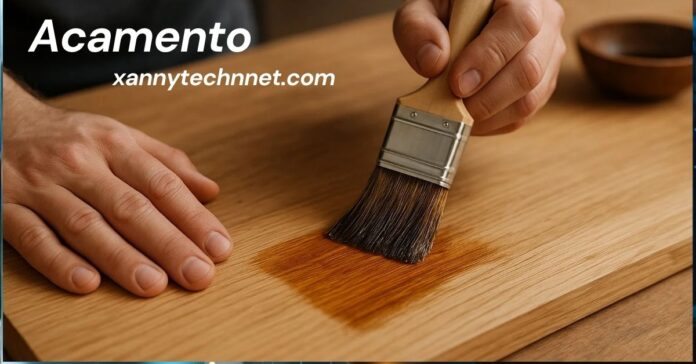Surface treatments are crucial to a variety of industries, and the term “acamento” refers to these treatments applied after the primary manufacturing or construction process. Acamento plays a vital role in enhancing the aesthetics, functionality, and durability of materials. This article explores the various facets of acamento, delving deep into its significance, types, benefits, applications, and future trends.
Acamento is an essential step in ensuring products withstand the test of time and perform optimally. Whether it’s a piece of art, an industrial product, or a piece of construction material, the finish applied determines its final look and its ability to endure various environmental challenges. Let’s explore the importance and impact of acamento in the modern world.
What is Acamento?
What Does Acamento Mean?
Acamento, a term originating from Latin roots, refers to the surface treatment applied to materials or products after their main construction or manufacturing. The purpose of acamento is not only to improve the look of the material but also to enhance its physical properties such as resistance to environmental factors like corrosion, wear, UV rays, and moisture. It’s a process that plays a dual role in making materials more functional while also adding an aesthetic finish.
The term “acamento” is often used interchangeably with surface treatments, coatings, or finishes, but it specifically refers to processes applied once the material has been fabricated to its basic form.

Why Is Acamento Important?
Acamento is essential for several reasons:
- Aesthetic Value: The finish gives materials a final appearance that can range from glossy to matte or textured, contributing to the overall design and appeal of the product.
- Durability and Protection: It protects materials from weathering, moisture, rust, and corrosion, especially in construction and automotive applications.
- Functional Enhancements: In industrial settings, acamento improves wear resistance, friction reduction, and ensures better performance of mechanical parts.
- Value Addition: Whether it’s in art, consumer electronics, or automotive components, acamento can increase the market value of a product due to its improved functionality and aesthetics.
Types of Acamento: Exploring Different Surface Treatments
Acamento involves various techniques that can be broadly categorized into physical treatments and chemical treatments, each suited for specific applications.
Physical vs. Chemical Treatments
- Physical Treatments: These are mechanical processes that alter the surface of materials without changing their chemical composition. Examples include polishing, brushing, and sanding. These methods enhance the smoothness, texture, and appearance of materials.
- Chemical Treatments: These treatments involve the application of chemical substances that alter the chemical composition of the material’s surface, such as coatings, anodizing, and galvanizing. Chemical treatments are typically used to improve the material’s corrosion resistance and durability.
Common Types of Acamento
- Paint and Coatings
- Paints and coatings are applied to provide a protective layer over surfaces, especially in metal products. Paints are used not just for aesthetic purposes but also to prevent rust and weathering. Types of coatings include powder coatings, liquid coatings, and ceramic coatings.
- Varnishing and Lacquering
- Varnish and lacquer treatments are commonly used in wood products to provide a glossy finish and to protect the surface from water damage, stains, and wear. The choice between varnish and lacquer depends on the desired finish and application.
- Galvanizing and Electroplating
- These are common techniques used to coat metals like steel or aluminum. Galvanizing involves coating the metal with zinc to prevent rust, while electroplating involves coating a material with a layer of metal using an electric current.
- Powder Coating
- Powder coating is a dry finishing process that provides a durable finish that is resistant to fading, scratching, chipping, and other types of wear and tear. It’s widely used in metal products, especially in the automotive and construction industries.
- Anodizing for Metals
- Anodizing is an electrochemical process that increases the thickness of the natural oxide layer on the surface of metals, primarily aluminum. This treatment enhances the corrosion resistance, hardness, and appearance of aluminum.
- Thermal Treatments
- Thermal treatments, such as heat treating and quenching, are applied to metals to alter their mechanical properties, such as hardness and strength. This is particularly useful in the production of industrial machinery and tools.

The Role of Acamento in Various Industries
Acamento is used extensively in a range of industries where surface durability, appearance, and functionality are paramount.
Acamento in the Construction Industry
In construction, acamento is crucial for ensuring the longevity and durability of building materials. For example, metal structures used in construction require galvanization or other coatings to prevent rust, while wooden materials are treated with varnishes to protect against moisture. The role of acamento in flooring (wood, tiles) or facade treatments (paint, coatings) is essential in maintaining aesthetic appeal and structural integrity over time.
Acamento in Manufacturing
In manufacturing, products ranging from electronics to automotive parts are treated with various surface treatments. Automotive parts undergo galvanizing or powder coating to protect against corrosion, while machinery parts might be anodized or coated to enhance their resistance to wear. Acamento ensures the functionality, reliability, and appeal of these products.
Acamento in Art and Design
The artistic community also uses acamento techniques. Sculptors and interior designers apply surface treatments to metals, ceramics, and woods to create textured, shiny, or aged finishes. Furniture pieces might be treated with varnish or lacquer to enhance their durability and aesthetic value.
Acamento Processes: Step-by-Step Breakdown
Preparation Phase
Before applying any surface treatment, materials must be prepared. This typically involves cleaning, sanding, or even etching the surface to ensure that the treatment adheres properly. For example, when preparing metal for electroplating, the surface must be cleaned of dirt, oil, and oxidation.
Application of Acamento
Also Read: eCryptobit.com Invest: A Comprehensive Guide to Cryptocurrency Investment Solutions
The process of applying acamento varies depending on the treatment type. For example:
- Powder coating involves spraying a dry powder onto a surface that is then heated to form a hard, protective layer.
- Anodizing involves immersing metal in an electrolytic solution to form an oxide layer.
- Varnishing involves applying a liquid coating to a surface and then allowing it to cure and harden.
Each process requires specific tools, temperatures, and environmental conditions to achieve the best results.
Post-Treatment Processes
Once the treatment is applied, the material must often go through a curing or drying phase. This allows the treatment to harden and fully bond with the surface. Quality control measures, such as inspecting the evenness of the coating or conducting durability tests, are crucial to ensure the treatment’s effectiveness.
Key Benefits of Acamento for Material Enhancement
Durability and Longevity
Acamento significantly extends the lifespan of products. Coatings such as galvanization prevent rust and corrosion in metals, while anodization enhances aluminum’s resistance to wear and tear.

Aesthetic Value
Acamento treatments enhance the visual appeal of products. Whether it’s the shine of lacquered wood or the textured finish of anodized aluminum, these treatments elevate the overall look and feel of the product, making it more desirable to consumers.
Functional Properties
Acamento also adds several functional properties such as heat resistance, waterproofing, scratch resistance, and anti-slip properties. These treatments help make products more functional in everyday use, contributing to their overall performance and reliability.
Challenges in the Acamento Process
Technical Challenges
Achieving uniformity in surface treatments can be challenging, particularly with irregularly shaped objects or large-scale manufacturing. Each material responds differently to treatments, and achieving the desired results requires expert knowledge and precision.
Environmental Impact
Some traditional surface treatments can have negative environmental impacts. For example, certain chemical treatments release harmful substances. However, eco-friendly alternatives such as water-based coatings, powder coatings, and green anodizing are emerging as sustainable solutions.
Choosing the Right Acamento for Your Product
Factors to Consider
- Material Type: Different materials require different types of surface treatments. Metals, wood, and plastics all have their own unique needs.
- Desired Finish: Depending on whether you need a glossy, matte, or textured finish, different techniques may be more suitable.
- End-Use Requirements: Consider the conditions the product will be exposed to, such as moisture, heat, UV light, or abrasion.
Best Practices in Acamento
Also Read: Spaietacle: A Dynamic Blog Platform for Curiosity and Insight
- Ensure proper surface preparation before applying any treatment.
- Follow application guidelines for each specific process.
- Invest in quality testing and inspection to ensure that the treatment is effective and long-lasting.

The Future of Acamento
Technological Advancements
As industries evolve, new technologies are improving surface treatments. Self-healing coatings are one example, where materials can repair small scratches automatically. Additionally, nano-coatings are becoming increasingly popular due to their superior protection and reduced environmental impact.
Industry-Specific Innovations
In the automotive and aerospace sectors, customized finishes are being developed to withstand extreme environmental conditions, such as high temperatures and chemical exposure. Future innovations could involve smart coatings that change based on the surrounding environment.
FAQs About Acamento
What is the purpose of acamento in manufacturing?
Acamento provides protection, enhances durability, and improves the aesthetic appeal of the final product.
How does acamento improve the lifespan of products?
Acamento enhances resistance to rust, corrosion, wear, and environmental factors, thereby improving the product’s longevity.
Are there eco-friendly alternatives to traditional acamento treatments?
Yes, water-based coatings, powder coatings, and green anodizing are eco-friendly alternatives gaining popularity in the industry.
Can acamento be applied to all materials?
While acamento is suitable for many materials, its application depends on the type of material and the desired result. For example, not all wood types are suitable for varnishing, and certain metals may require specialized coatings.
What industries use acamento the most?
Acamento is widely used in industries such as construction, manufacturing, automotive, electronics, and art and design.
Conclusion
Acamento plays a pivotal role in enhancing the functionality and appearance of materials across multiple industries. As technology evolves, so does the process of acamento, with innovations making treatments more sustainable and effective. Understanding the different types and benefits of acamento can help manufacturers and artists alike to choose the most appropriate treatment to enhance their products’ performance and appeal.
